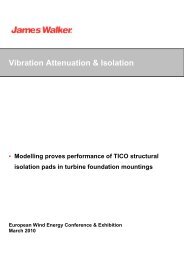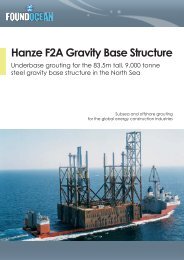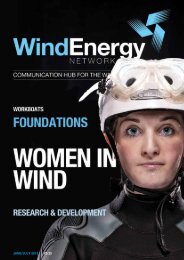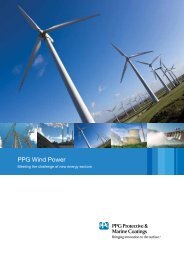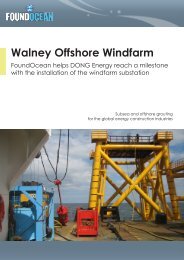WORKING AT HEIGHTS - Wind Energy Network
WORKING AT HEIGHTS - Wind Energy Network
WORKING AT HEIGHTS - Wind Energy Network
Create successful ePaper yourself
Turn your PDF publications into a flip-book with our unique Google optimized e-Paper software.
LubricaTION & Filtration featureQ: Why is lubrication such anessential component of windturbine performance?Robert: “<strong>Wind</strong> turbine maintenancepresents an array of challenges that canhinder productivity.“The main gearbox drives the generatorand is the heart of a wind turbine. Withtheir advanced designs and overallimportance to system performance,gearboxes can be very costly and timeconsuming to repair or replace after thewarranty expires.“For example, when factoring in allexpenses, replacing a gearbox for a 1.4MW turbine can cost a company morethan US $625,000, including the price ofa new gearbox, labour costs, crane rentaland lost revenue from turbine downtime.“In remote locations like offshore,maintenance and repair costs are likelyto be even higher and after the warrantyperiod or extended service contractperiod, the operator becomes responsiblefor keeping the turbine running for theremainder of its service life.“For the main gearbox – just as forall pieces of industrial equipment –lubrication plays a vital role in optimisingperformance and minimising downtime.”Q: What are the key challengesfacing wind turbine operatorsand maintenance personnel?Robert: “Maintaining the performanceand prolonging the life span of themain gearbox is the greatest lubricationchallenge in a wind turbine. The mostcommon cause of gearbox downtime isrelated to bearing failure. Consideringthe variable load, high speed anddramatic temperature conditions windturbines operate under, bearings areput under a significant amount of stress.These factors, combined with improperlubrication, can result in the need forbearing replacements, and if damagedbearings are not replaced promptly,significant harm to the gear can occur.“Another issue is the industry-wide driveto minimise up-tower weight. It hasresulted in compact gearbox designswhich, in combination with high loadsfound in wind turbines, means thesurface-hardened gears are susceptibleto micro-pitting, which can causenumerous surface cracks. The crackspropagate at a shallow incline to thesurface, forming extremely small pits thatmay reduce gear tooth accuracy andlead to significant gear damage.“In addition to protecting against micropittingand other forms of equipmentwear, Mobilgear SHC XMP 320 exceedsthe performance of traditional oils byextending the interval between oil changesfrom 18 months to five years or more.Extended oil life translates into a varietyof benefits, including reduced volume ofoil purchases, used-oil disposal volumes,maintenance effort and lubricant-relateddowntime for oil changes.”Q: Why does using syntheticlubricants vs. conventional oilsmake such a difference in windturbine applications?Robert: “Case-hardened gears exposedto unpredictable winds and high loadsmeans wind turbines are susceptibleto micro-pitting, and require a gearlubricant that protects against this typeof wear.“Upgrading to synthetic lubricants bringsa number of advantages, includinglonger equipment life, high-temperaturecapability and excellent resistance tooxidation - which can help maximise theperformance of wind turbines.“The extreme conditions wind turbinesare subjected to are easily endured byhigh-performance synthetic lubricants,which can improve film strength atoperating temperature by nearly 50percent. By comparison, conventional,mineral-based fluids cannot deliverthe same level of protection. Thesekinds of performance advantages canhelp companies generate significantbottom line savings and enable them tomaximise productivity.”Q: What are the best practicesfor wind turbine oil filtration?Robert: “There are several types ofoil filters. The first step in identifyingthe appropriate filter for a turbine is todetermine what level of oil cleanliness isrequired for proper function.“There are a variety of factors to considerwhen making this decision, including themachine’s OEM cleanliness standards,filter micron size, beta rating and the kindsof contaminants being removed, be theydirt, water or wear metals. Manufacturersmust also consider oil flow and determinethe flow-rate of the pump moving theoil. Filter capacity has to either match orexceed the pump flow rate, to preventfilter malfunction or back-pressure build up.“Typically wind turbines are equippedwith two oil filtration systems. The primarysystem filters oil prior to delivering it to thegears and bearings. The auxiliary systememploying finer filtration is designed toaugment the primary system, focusingon maintaining the required systemcleanliness. A duplex housing should beused as it allows for filter changes duringnormal operation.“Finally, proactive filter maintenanceis critically important. Maintenancepersonnel should take routine samplesto determine overall cleanliness of the oiland effectiveness of the filter. The filtershould also have a tattletale—usually apressure gauge mounted in the housing—that indicates when the filter needs to bechanged.”Q: What are the most commonmistakes made with respect tooil filtration?Robert: “Over-filtration is a commonproblem.“While a filtration system is designedto eliminate contaminants, removingexcessively fine particles maynegatively impact oil additive balance.It is crucial to pay close attention tothe OEM recommendations for oilsystem cleanliness, as exceeding thatspecification may actually hinder theperformance of the lubricant.”Robert PearsIndustrial Lubricants expertExxonMobil Lubricants & Specialtieswww.exxonmobil.co.ukClick to view more infowww.windenergynetwork.co.uk71



